Physical Characterization and In Vitro Toxicity Test of PDMS Synthesized from Low-Grade D4 Monomer as a Vitreous Substitute in the Human Eyes
Abstract
1. Introduction
2. Materials and Methods
3. Results
3.1. PDMS Properties
3.2. IR Spectra of PDMS
3.3. In Vitro Toxicity Test
4. Discussion
5. Conclusions
Supplementary Materials
Author Contributions
Funding
Institutional Review Board Statement
Informed Consent Statement
Data Availability Statement
Acknowledgments
Conflicts of Interest
References
- Kartasasmita, A.; Kusdiono, W.; Virgana, R.; Boesorie, S. In Vivo Emulsification Analysis of 1000 cs and 5000 cs Silicone Oil after Rhegmatogenous Retinal Detachment Vitrectomy Surgery. Open J. Ophthalmol. 2007, 7, 231–239. [Google Scholar] [CrossRef][Green Version]
- Giordano, G.G.; Refojo, M.F. Silicone Oils as Vitreous Substitutes. Prog. Polym. Sci. 1998, 23, 509–532. [Google Scholar] [CrossRef]
- Nusa, H.S.; Astuti, W.; Kartasasmita, A.S.; Virgana, R.; Syakir, N.; Bahtiar, A.; Safriani, L.; Risdiana. Characterization of Optical and Structure Properties of Polydimethylsiloxanes. Mater. Sci. Forum 2015, 827, 99–104. [Google Scholar] [CrossRef]
- Caramoy, A.; Schröder, S.; Fauser, S.; Kirchhof, B. In Vitro Emulsification Assessment of New Silicone Oils. Br. J. Ophthalmol. 2010, 94, 509–512. [Google Scholar] [CrossRef] [PubMed]
- Romano, M.; Ferrara, M.; Gatto, C.; Giurgola, L.; Zanoni, M.; Angi, M.; Rinaldi, M.; Borgia, A.; Sorrentino, T.; Tothova, J.D. Safety of Silicone Oils as Introcular Medical Device: An In Vitro Cytotoxicity Study. Exp. Eye Res. 2020, 194, 108018. [Google Scholar] [CrossRef] [PubMed]
- Nakamura, K.; Refojo, M.F.; Crabtree, D.V.; Pastor, J.; Leong, F.L. Ocular Toxicity of Low-Molecular-Weight Components of Silicone and Fluorosilicone Oils. Investig. Ophthalmol. Vis. Sci. 1991, 32, 3007–3020. [Google Scholar]
- Brunner, S.; Izay, B.; Weidinger, B.; Maichel, B.; Binder, S. Chemical Impurities and Contaminants in Different Silicone Oils in Human Eyes before and After Prolonged Use. Graefe’s Arch. Clin. Exp. Ophthalmol. 2010, 249, 29–36. [Google Scholar] [CrossRef] [PubMed]
- Tavaszi, J.; Budai, P. Toxicity study of agrochemicals on chorioallantoic membrane of the egg. Commun. Agric. Appl. Biol. Sci. 2006, 71, 101–105. [Google Scholar] [PubMed]
- Walum, E.; Balls, M.; Bianchi, V.; Blaauboer, B.; Bolcsfoldi, G.; Guillouzo, A.; Moore, G.A.; Odland, L.; Reinhardt, C.; Spielmann, H. ECITTS: An integrated approach to the application of in vitro test systems to the hazard assessment of chemicals. Altern. Lab. Anim. 1992, 20, 406–428. [Google Scholar] [CrossRef]
- Leighton, J.; Nassauer, J.; Tchao, R. The Chick Embryo in Toxicology: An Alternative to the Rabit Eye. Food Chem. Toxicol. 1985, 23, 293–298. [Google Scholar] [CrossRef]
- Valdes, T.I.; Kreutzer, D.; Moussy, F. The chick chorioallantoic membrane as a novel in vivo model for the testing of biomaterials. J. Biomed. Mater. Res. 2002, 82, 273–282. [Google Scholar] [CrossRef] [PubMed]
- Auliya, D.G.; Setiadji, S.; Agasa, Z.M.; Fitrilawati; Syakir, N.; Risdiana. Synthesis of Low Viscosity Polydimethylsiloxane Using Low Grade of Octamethylcyclotetrasiloxane. Mater. Sci. Forum 2021, 1028, 365–370. [Google Scholar] [CrossRef]
- Setiadji, S.; Agasa, Z.M.; Auliya, D.G.; Fitrilawati; Syakir, N.; Noviyanti, A.R.; Rahayu, I.; Supriadin, A.; Risdiana. Synthesis and Characterization of Polydimethylsiloxane (PDMS) with Medium Viscosity via Ring-Opening Polymerization. Mater. Sci. Forum 2021, 1028, 346–351. [Google Scholar] [CrossRef]
- ICCVAM. Recommended Test Method Protocol: Hen’s Egg Test–Chorioallantoic Membrane (HET-CAM) Test Method. Available online: http://iccvam.niehs.nih.gov/methods/ocutox/MildMod-TMER.htm (accessed on 28 April 2021).
- Swindle, K.E.; Ravi, N. Recent advances in polymeric vitreous substitutes. Expert Rev. Ophthalmol. 2007, 2, 255–265. [Google Scholar] [CrossRef]
- Hagino, S.; Kinoshita, S.; Tani, N.; Nakamura, T.; Ono, N.; Konishi, K.; Iimura, H.; Kojima, H.; Ohno, Y. Interlaboratory validation of in vitro eye irritation tests for cosmetic ingredients. (2) Chorioallantoic membrane (CAM) test. Toxicol. Vitro 1999, 13, 99–113. [Google Scholar] [CrossRef]
- Mackiewicz, J.; Muhling, B.; Hiebl, W.; Meinert, H.; Maaijwee, K.; Kociok, N.; Luke, C.; Zagorski, Z.; Kirchhof, B.; Joussen, A.M. In Vitro Retinal Tolerance of Various Heavy Silicone Oils. Investig. Ophthalmol. Vis. Sci. 2007, 48, 1873–1883. [Google Scholar] [CrossRef] [PubMed]
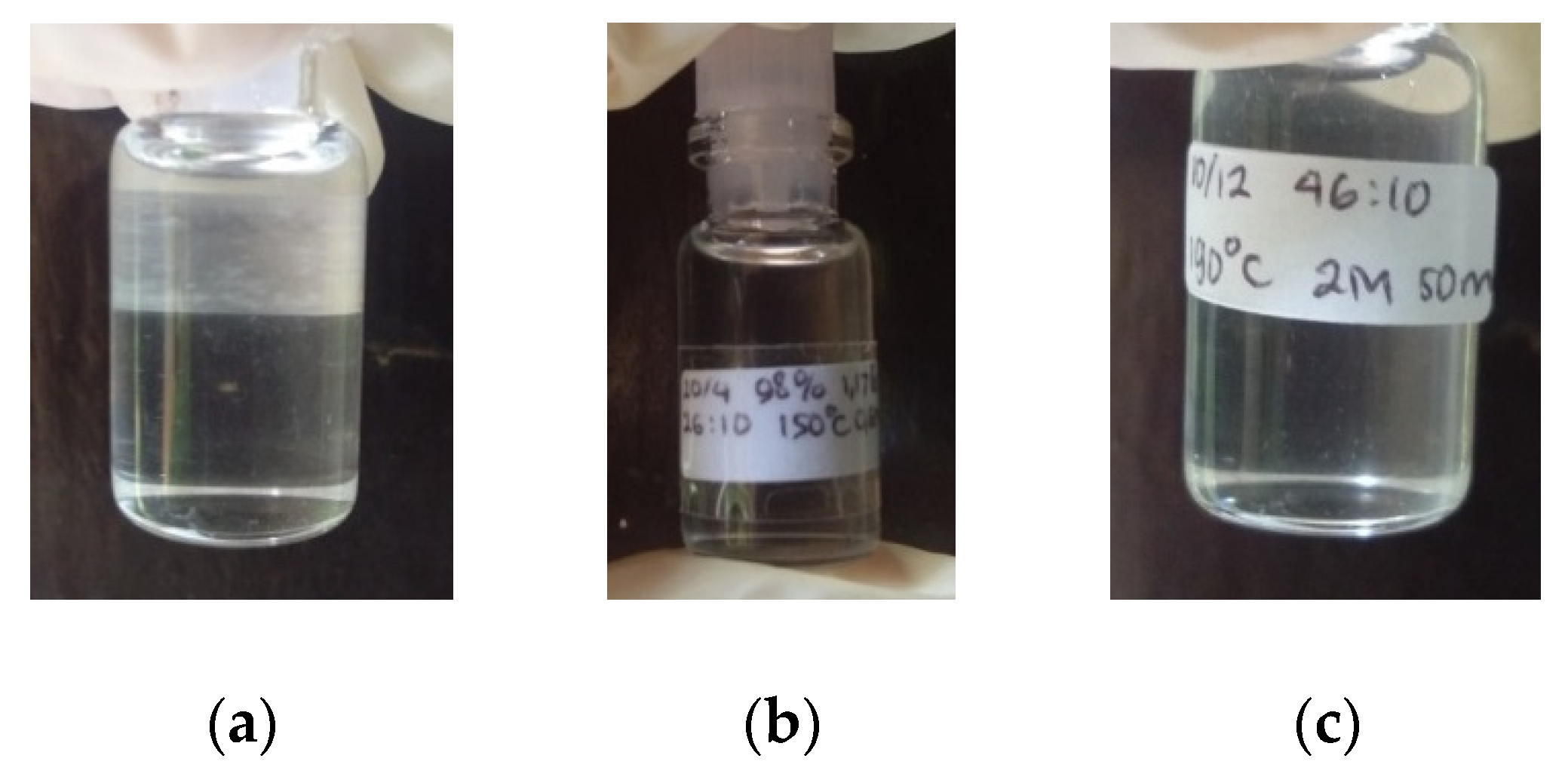

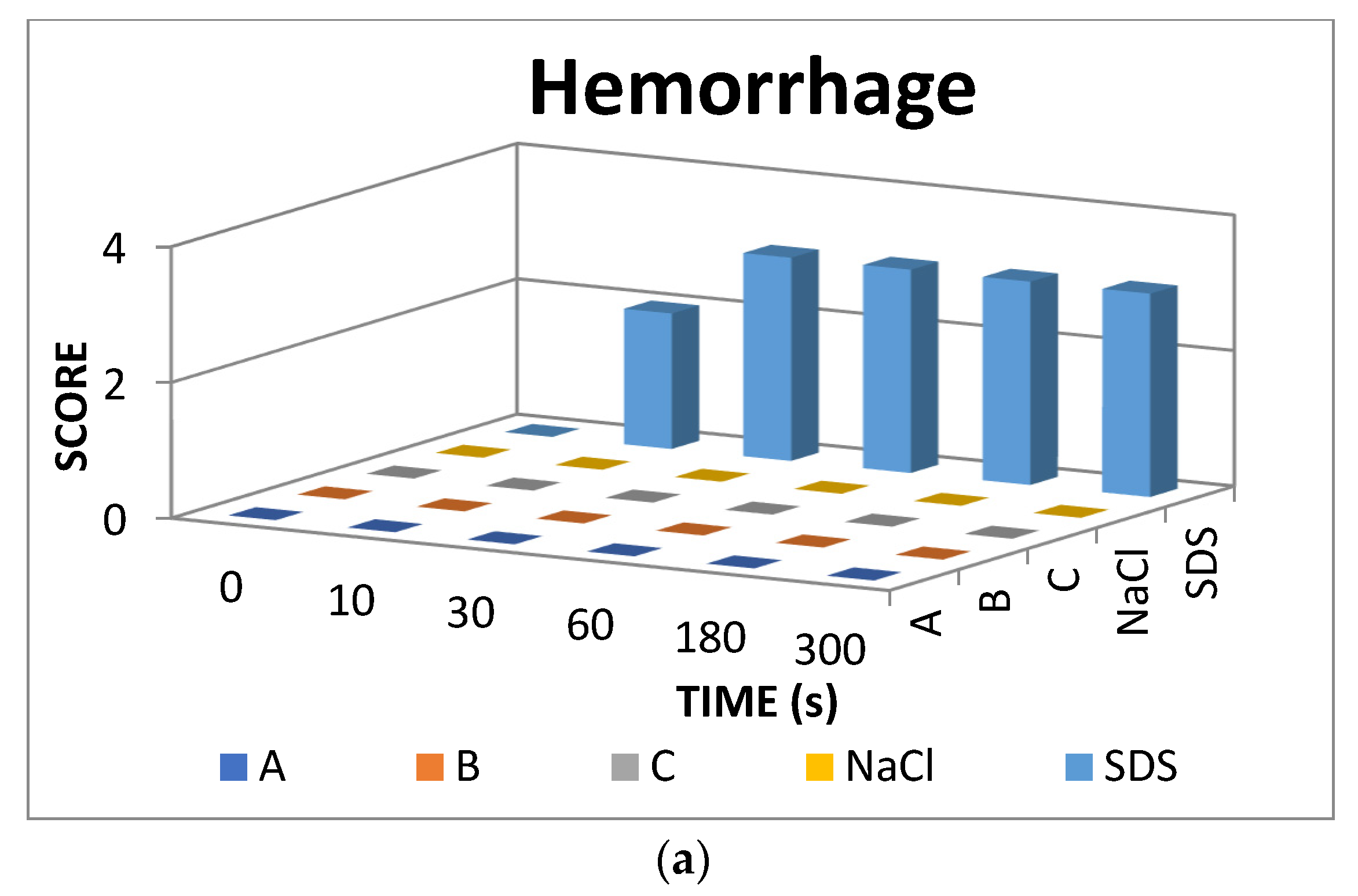
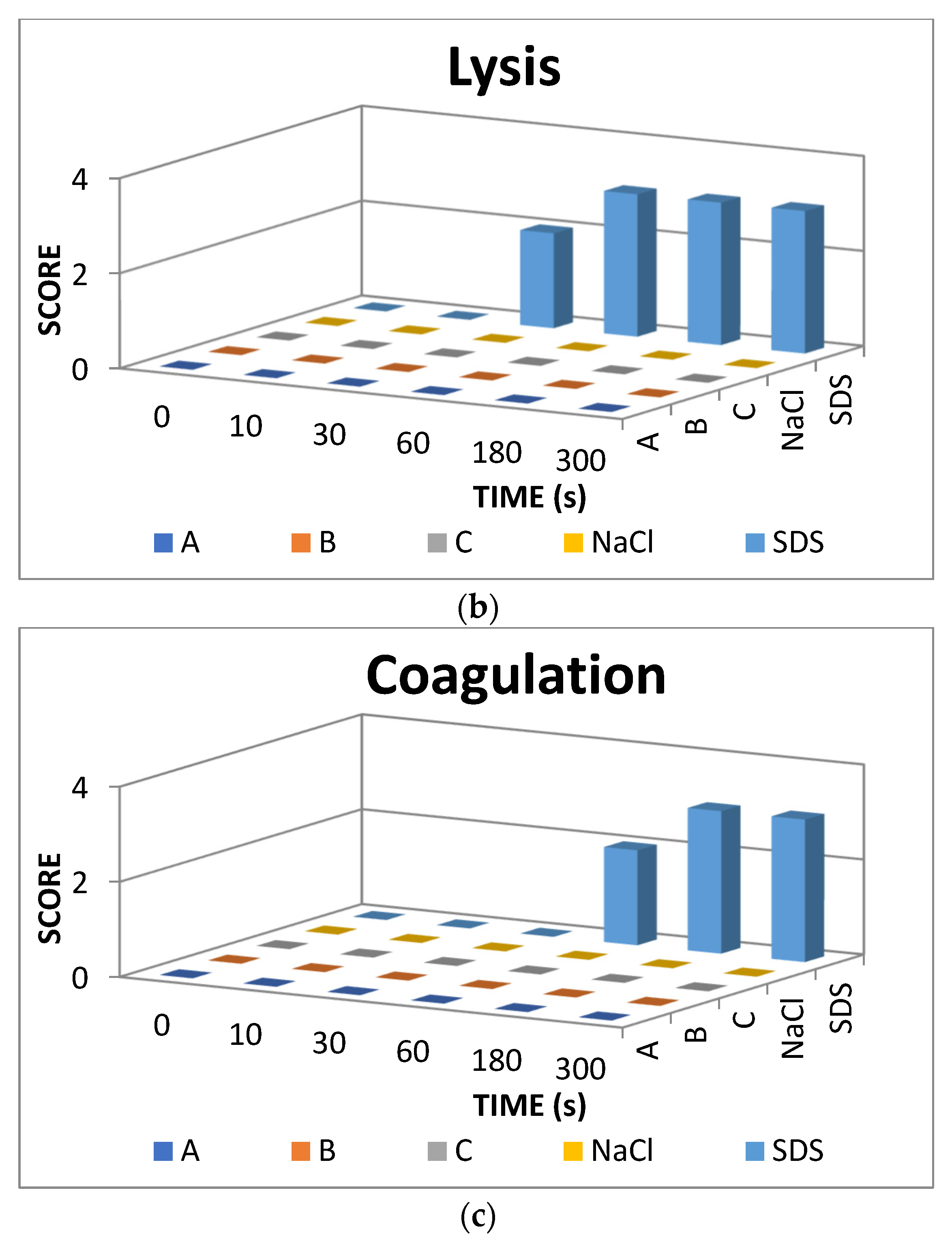
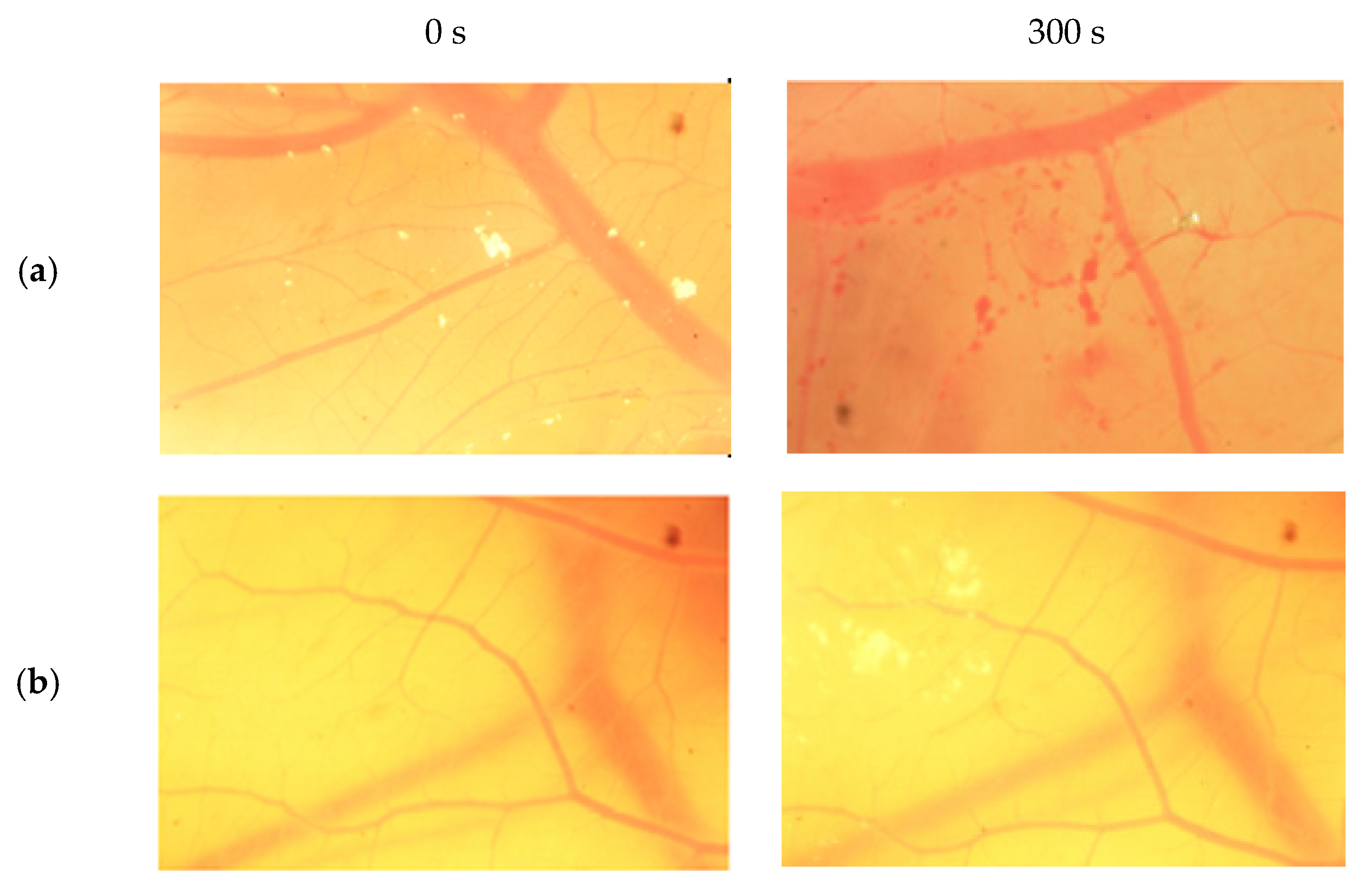
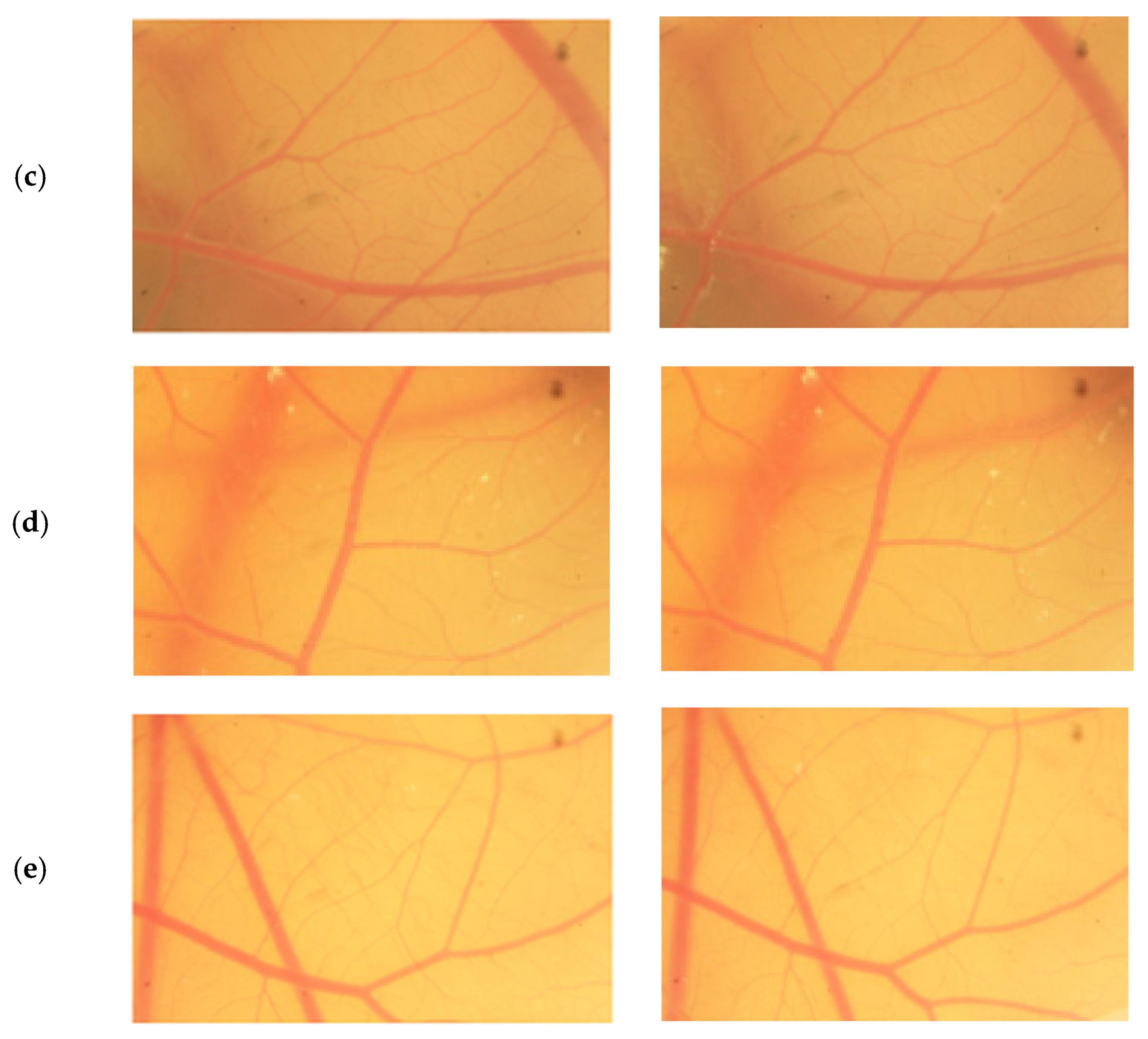
| Condition | A | B | C |
|---|---|---|---|
| Purity of D4 (%) | 96 | 98 | 96 |
| Ratio of D4:MM | 26:10 | 26:10 | 46:10 |
| Synthesis Temperature (°C) | 190 | 150 | 190 |
| KOH Concentration (M) | 2 | 0.6 | 2 |
| Time of Polymerization (minute) | 50 | 16 | 50 |
| Area of the Endpoint (%) | Score |
|---|---|
| 0–10 | 0 |
| 10–30 | 1 |
| 30–60 | 2 |
| 60–100 | 3 |
| Sample | η (Pa.s) | Yield (%) | n | Additional Diopters | γ (mN/m) |
|---|---|---|---|---|---|
| A | 1.15 | 67.37 | 1.4040 | 3.410 | 21 |
| B | 1.17 | 54.59 | 1.3993 | 3.179 | 19 |
| C | 1.81 | 71.31 | 1.4048 | 3.449 | 21.5 |
| No | Functional Group | Wavenumber (cm−1) | |||
|---|---|---|---|---|---|
| Commercial [13] | A | B | C | ||
| 1 | Si-O-Si | 500, 703 | 523, 700 | 551, 695 | 519, 701 |
| 2 | Si-C stretching and CH3 rocking | 792, 871 | 803, 864 | 807, 863 | 799, 864 |
| 3 | Si-O-Si stretching | 1112, 1023 | 1023 1099 | 1023, 1075 | 1019, 1093 |
| 4 | CH3 symmetric deformation of Si-CH3 | 1263 | 1261 | 1261 | 1260 |
| 5 | CH3 asymmetric deformation of Si-CH3 | 1412 | 1413 | 1412 | 1412 |
| 6 | OH | 1600, 3643– 3828 | 1600, 3595– 3823 | 1600, 3643– 3828 | 1602, 3593– 3828 |
| 7 | Si-C | 1945, 2052 | 1945, 2052 | 1945, 2052 | 1945, 2052 |
| 8 | CH | 2500, 2663 | 2500, 2663 | 2500, 2663 | 2500, 2663 |
| 9 | CH stretching of CH3 | 2906, 2972 | 2906, 2963 | 2906, 2964 | 2906, 2964 |
Publisher’s Note: MDPI stays neutral with regard to jurisdictional claims in published maps and institutional affiliations. |
© 2021 by the authors. Licensee MDPI, Basel, Switzerland. This article is an open access article distributed under the terms and conditions of the Creative Commons Attribution (CC BY) license (https://creativecommons.org/licenses/by/4.0/).
Share and Cite
Auliya, D.G.; Setiadji, S.; Fitrilawati, F.; Risdiana, R. Physical Characterization and In Vitro Toxicity Test of PDMS Synthesized from Low-Grade D4 Monomer as a Vitreous Substitute in the Human Eyes. J. Funct. Biomater. 2022, 13, 3. https://doi.org/10.3390/jfb13010003
Auliya DG, Setiadji S, Fitrilawati F, Risdiana R. Physical Characterization and In Vitro Toxicity Test of PDMS Synthesized from Low-Grade D4 Monomer as a Vitreous Substitute in the Human Eyes. Journal of Functional Biomaterials. 2022; 13(1):3. https://doi.org/10.3390/jfb13010003
Chicago/Turabian StyleAuliya, Diba Grace, Soni Setiadji, Fitrilawati Fitrilawati, and Risdiana Risdiana. 2022. "Physical Characterization and In Vitro Toxicity Test of PDMS Synthesized from Low-Grade D4 Monomer as a Vitreous Substitute in the Human Eyes" Journal of Functional Biomaterials 13, no. 1: 3. https://doi.org/10.3390/jfb13010003
APA StyleAuliya, D. G., Setiadji, S., Fitrilawati, F., & Risdiana, R. (2022). Physical Characterization and In Vitro Toxicity Test of PDMS Synthesized from Low-Grade D4 Monomer as a Vitreous Substitute in the Human Eyes. Journal of Functional Biomaterials, 13(1), 3. https://doi.org/10.3390/jfb13010003






